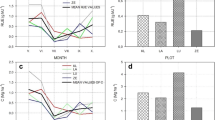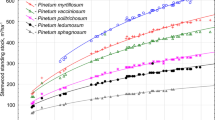Summary
Knowledge of how energy budget components vary with time, vegetation type and stage of development and field size is important if we are to increase our understanding of the energy budget on a regional scale. The aim of this study was to quantify the seasonal and diurnal variation of energy budget components of a 2.6 ha short-rotation stand. Measurements were made using a thermometer interchange system for gradient and Bowen ratio estimations. Energy storage in soil, air and biomass was determined from temperature and humidity measurements. The partitioning of available energy between sensible and latent heat fluxes changed drastically at the beginning of the season. From the first half of May until the second half of June the maximum (noon) latent heat flux increased by a factor of 3, the total storage decreased by a factor of 2 and the sensible heat flux decreased by a factor of 4.5, while net radiation was unchanged. The vapour pressure deficit was similar during these periods but the leaf area index increased from about zero to three. On a mean monthly basis, the sensible heat flux was negative (directed towards the surface) from June to October, i.e., during most of the season. Heat was supplied to the atmosphere only at the beginning of the season for this type of short-rotation stand. Heat storage in air and biomass was significant on an hourly basis, especially in mornings and evenings when it could be of the same order as the net radiation. It was concluded that the development stage of the short-rotation stand had a large influence on how the energy was distributed between the convective fluxes. It was also concluded that storage in air and biomass had to be accounted for if precise estimates of energy balance on a shorter (hourly) time scale were required.
Similar content being viewed by others
References
André, J.-C., Goutorbe, J.-P., Perrier, A., 1986: HAPEX-MOBILHY: A hydrologic atmospheric experiment for the study of water budget and evaporation flux at the climatic scale.Bull. Amer. Meteor. Soc. 67, 138–144.
Gash, J. H. C., Shuttleworth, W. J., Lloyd, C. R., 1989: Micrometeorological measurements in les Landes forest during HAPEX-MOBILHY.Agric. Forest Meteor. 46, 131–147.
Grip, H., Halldin, S., Lindroth, A., 1989: Water use by intensively cultivated willow using estimated stomatal parameter values.Hydrological Processes 3, 51–63.
Hartley, H. O., 1961: The modified Gauss-Newton method for the fitting of non-linear regression functions by least squares.Technometrics 3, 269–280.
Jarvis, P. G., James, G. B., Landsberg, J. J., 1976: Coniferous forests. In: Monteith, J. L. (ed.)Vegetation and the Atmosphere, Vol. 2, Case Studies. London: Academic Press, 171–240.
Kimball, B. A., 1974: Smoothing data with Fourier transformations.Agron. J. 66, 259–262.
Kimball, B. A., Jackson, R. D., 1975: Soil heat flux determination: A null-alignment method.Agricultural Meteorology 15, 1–9.
Lindroth, A., 1985: Seasonal and diurnal variation of energy budget components in coniferous forests.J. Hydrol. 82, 1–15.
Lindroth, A., Halldin, S., 1988: Vattenförbrukning och bevattningsbehov vid energiskogsodling i Götaland och Svealand. (Water use and irrigation need for willow forestry in southern Sweden. In Swedish with English summary).Vatten 44(1), 44–53.
Lindroth, A., Halldin, S., 1990: Gradient measurements with fixed and reversing temperature and humidity sensors above a thin forest.Agric. Forest Meteor. 53, 81–104.
Lindroth, A., Iritz, Z., 1990. Aktuell avdunstning i förhållande till potentiell iavdunstning från ett bevattnat energiskogsbestånd. (Actual evaporation in relation to potential evaporation from an irrigated short-rotation willow stand. In Swedish with English summary). In: Sigurdsson, G. (ed.)Nordisk Hydrologisk Konferens 1990, Kalmar, Sverige 29 Juli–1 Augusti 1990. Nordiskt Hydrologiskt Program, NHP-rapport nr 26, Nordisk Hydrologisk Förening, Norrköping, 42–51.
MathWorks, Inc., 1989:MATLAB for 80386-based MS-DOS Personal Computers. User's Guide. Massachusets: The MathWorks Inc., 21 Eliot Street, South Natick. 374 pp.
McCaughey, J. H., Saxton, W. L., 1988: Energy balance storage terms in a mixed forest.Agric. Forest Meteor. 44, 1–18.
Moore, C. J., Fisch, G., 1986: Estimating heat storage in Amazonian tropical forest.Agric. Forest Meteor. 38, 147–169.
Nilsson, L. O., 1981.Methods of Determining Dry Matter Content and Growth in Energy Forest Plantations. Technical Report 19, Swedish Energy Forestry Project, Swedish University of Agricultural Sciences, Uppsala, 47 pp.
Penman, H. L., Angus, D. E., Bavel, C. H. van, 1967: Microclimatic factors affecting evaporation and transpiration.Agronomy 11, 483–505.
Penman, H. L., 1948: Natural evaporation from open water, bare soil and grass.Proceedings of the Royal Society, Series A,193, 120–145.
Persson, G., Jansson, P.-E., 1989: Simulated water balance of a willow stand on clay soil. In: Perttu, K. L., Kowalik, P. J. (eds.)Modelling of Energy Forestry: Growth, Water Relations and Economics. Wageningen: Simulation Monographs 30, Pudoc, 147–162.
Sá, L. D. A., Viswanadham, Y., Manzi, A. O., 1988: Energy flux partitioning over the Amazon Forest.Theor. Appl. Climatol. 39, 1–16.
Tanner, C. B., 1960: Energy balance approach to evapotranspiration from crops.Soil Science Society of America, Proceedings 24, 1–9.
Verwijst, T., 1990: Clonal differences in the structure of a mixed stand of Salix viminalis in response to Melampsora and frost.Canadian J. Forest Research 20, 602–605.
Zar, J. H., 1968: Calculation and miscalculation of the allometric equation as a model in biological data.Bioscience 18, 1118–1120.
Author information
Authors and Affiliations
Additional information
With 5 Figures
Rights and permissions
About this article
Cite this article
Lindroth, A., Iritz, Z. Surface energy budget dynamics of short-rotation willow forest. Theor Appl Climatol 47, 175–185 (1993). https://doi.org/10.1007/BF00867449
Received:
Revised:
Issue Date:
DOI: https://doi.org/10.1007/BF00867449




